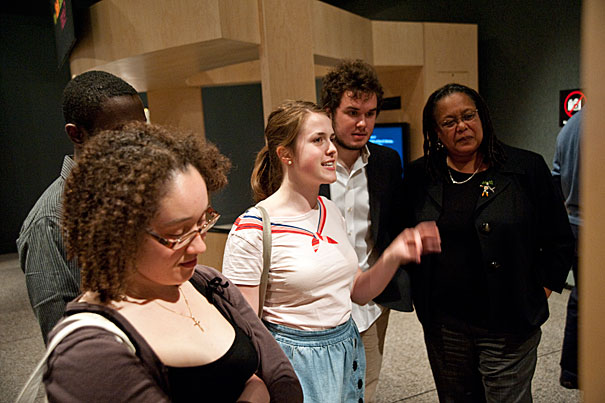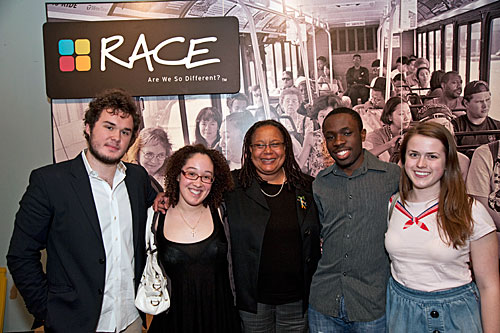
“This exhibit is really an extension of the discussion we had in my course about how we organize our societies,” said Harvard College Dean Evelynn M. Hammonds (right). “The goal for students is to understand that race is a human construct, and to be aware of the way that notions about race shape the world around them, which is filled with people of all colors and people who are different in various kinds of ways.”
Photos by Jon Chase/Harvard Staff Photographer
Not black and white
College dean, students reflect on race and science
Four Harvard College freshmen huddled around an iPad, trying to identify the race of the man in the picture before them. It was harder than they thought it would be.
“That’s not a race,” said Rachel Gladstone as she looked at one of the choices on the bottom of the screen.
“He’s Jewish,” said Morgan Matthews.
“Look, you say what it is, and we’ll choose something else,” joked Luka Oreskovic.
“How about Red Sox Nation?” asked Jermaine Heath. (It was, to be fair, an actual choice.)
The four were playing a learning game designed for “Race: Are We So Different?,” an exhibit at Boston’s Museum of Science (MOS) that tells the story of race in the United States by exploring the science of human variation, the history of the idea of race, and contemporary experience. The students visited the MOS in May on a field trip organized by Harvard College Dean Evelynn M. Hammonds, their teacher last fall for the freshman seminar “The Concept of Race in Science and Medicine in the United States.”
“This exhibit is really an extension of the discussion we had in my course about how we organize our societies,” said Hammonds, the Barbara Gutmann Rosenkrantz Professor of the History of Science and professor of African and African-American studies. “The goal for students is to understand that race is a human construct, and to be aware of the way that notions about race shape the world around them, which is filled with people of all colors and people who are different in various kinds of ways.”
Gladstone said she was surprised to discover her own misconceptions about race when she took Hammonds’ seminar.
“We watched a video about kids who were doing an experiment,” Gladstone said. “They took their DNA and sequenced it. They were all different races and they tried to predict whose DNA would be most similar in sequence to each other. I realized that I had preconceptions also about these two people of the same race. I thought that they would have a more similar DNA sequence, but it turned out that actually that wasn’t the case at all. There are physical differences between people, but the fact is that the majority of our DNA sequence is the same, even between people who look different.”
At the MOS exhibit, Gladstone’s classmate Heath read about sickle cell anemia and learned that, while it disproportionately affects African Americans in the United States, the disease itself is tied to place, rather than ethnicity. (The gene that causes sickle cell also provides protection against malaria, which mostly occurs in sub-Saharan Africa.) He said the exhibit made him think about the implications of race-based medicine.
“There are some underlying problems when you assume that, based only on race, some health problems — for example, heart disease and hypertension among African Americans — will always exist,” he said. “I think that genetic, evidence-based medicine would be a real advance, but right now, I think we tend to interpret results from our own perspective or a false perspective. We may have helpful data, but we’ll interpret it to be about things that are not naturally occurring.”

The students in Hammonds’ class were themselves a diverse bunch. Heath grew up in Brooklyn, N.Y., the son of Jamaican immigrant parents. Other students in the class were from Africa or of Asian descent. Matthews looked at a display that showed the world’s genetic diversity and its origins in Africa and reflected on her own experience.
“In science sometimes you classify by geographic origin,” she said. “But for me, I’m Canadian. I’m also heavily identified with the fact that my mom’s black and my dad’s white. My geographic origin would probably be Ireland or Africa. Here at the exhibit, you see how people classify themselves, which may not be how scientists would classify them. And how we classify people really affects the science that we’re doing.”
Hammonds — a member of the MOS board of directors who returned to the exhibit on May 10 to host a conversation on race with award-winning actress Anna Deavere Smith — said that many young people don’t experience racism or discrimination in the same ways that their parents or grandparents did. The fact that students have grown up in a more diverse society is a good thing, but it can also make it hard for young people to identify the ways that race continues to shape the world around them. As an example, she pointed to President Barack Obama, a symbol to some of a post-racial society. Hammonds noted that the president is usually considered black or half-black, rather than white or half-white, a distinction that has more to do with our notions of race than with science.
“Biologically, he’s as white as he is black,” she said. “He can’t call himself white, though, because he is phenotypically not white. That has to do with the way we understand people and the way we look at difference as a part of our world. We think that the legacy of racial difference is history, but it still plays out in our contemporary culture every day.”
Matthews stood in front of a display that showed how the U.S. census had changed racial categories over time. She said that the class and the exhibit made her reconsider some of the ideas that she grew up with.
“Race was always a concept that was just kind of accepted,” she said. “It’s something from birth that’s so ingrained in you. The class really challenged that notion. There’s a lot of nuance. It’s not just black and white.”




